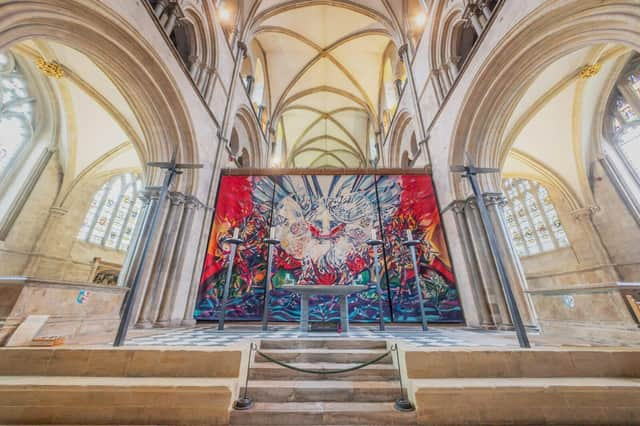Beloved tapestry returns to Chichester Cathedral following repairs


The exuberant three-part Benker-Schirmer tapestry has come home to Chichester Cathedral following conservation work to preserve its future. The tapestry had been removed following the discovery of an infestation of moths in the Quire stalls in March 2022, also necessitating the removal of the High Altar tapestry by John Piper (1966) and kneelers. The Cathedral used a specialist studio in Brighton to carry out the conservation work. Zenkie Tinker from the studio reported cleaning took 88 hours and the moth damage had been considerable.
Following a deep clean, the tapestry has been lined with an unbleached, acid-free cotton backing which will help prevent the development of mould and fungi on the rear of the tapestry and the build-up of dust and dirt deep into the threads. The cost of this specialist lining was funded by the Chichester Cathedral Friends. In May 2023 the conservators worked alongside the Cathedral works team to re-hang the tapestry onto the medieval screen which has also been deep cleaned.
Advertisement
Hide AdAdvertisement
Hide AdDuring cleaning one of the tapestry’s original weavers, Ananda King, paid a visit to the studio and was delighted to be reunited with the tapestry describing it as “an old friend”. Ananda recounted the teamwork and development of bonds, but also frayed tempers, amongst the team of weavers as they worked over a three-year period to complete the tapestry. In three parts, the centre section was woven first in Germany and the two side panels subsequently woven at West Dean’s tapestry studio, north of Chichester. Ananda worked both in Germany and at West Dean with the equipment, cartoons and balls of thread being transported between the two sites.


Ananda explained the challenge of achieving uniformity in the weave and design across the three sections woven in two different places and the frustrations of lining up the side panels. Speaking to Canon Treasurer Vanessa Baron, Ananda describes her experience of weaving the tapestry and the process of tapestry weaving and how it differs to cloth weaving in which she originally trained.
Designed by Ursula Benker-Schirmer (1927-2020), using rock crystal fragments as her inspiration, the tapestry colours were chosen by Ursula with the Cathedral’s stained glass panels in minds including the nearby Marc Chagall window. The linen, silk and cotton threads were dyed in Ursula’s studios and each tone given a code to ensure the consistency of colour throughout the tapestry. The tapestries, which measure 7 metres wide and three metres high overall, are wound onto a roller on the loom during the weaving process, disappearing from view until the hanging. At the end, the signatures of the two weaving studios are woven into the top and bottom edges.
The Anglo-German collaboration was to represent ‘reconciliation’ between the British and German peoples after the second world war. The tapestry illustrates some of the miracles associated with St Richard who was Bishop of Chichester from 1245 to 1253. Among the many symbols in the tapestry is a chalice, located in the centre under the cross, which is symbol of St Richard himself. The red wine at the base represents the blood of Christ. Dedicated in June 1985, the tapestry forms a key part of the Shrine of St Richard.
The Cathedral became an important place of pilgrimage after St Richard’s death. The Shrine today is a focus for prayer and the tapestry is at its spiritual centre.